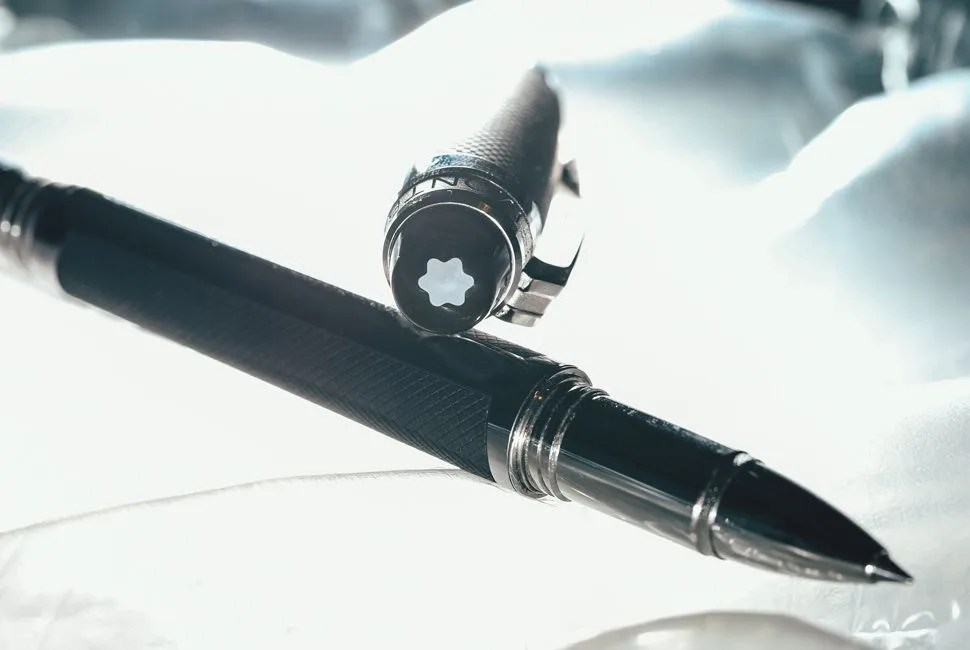The question that will forever accompany a $1,000 pen is easy to spell out: Why? Montblanc International, who’s named after the highest mountain in the Alps and has been making writing instruments since 1909 in Germany, responds (in around six different languages in their owner’s manual): because it has a soul. Because it’s a masterpiece. Because it “reflects the timeless aesthetic of the sophisticated, cultivated personality of [its owner].” If “to hold a pen is to be at war”, as Voltaire said, Montblanc suggests you show up in full dress uniform, ready to go down like an officer and a gentleman among the Bic-wielding hordes.
MORE WRITING GOODS: Best Stationery for Men | How to Write a Letter Like Steinbeck | Breaking Down the Perfect Writer’s Shed
The Starwalker Screenwriter Extreme Steel ($1,085) I’d been lent to test didn’t look like the fountain pens I first fawned over when I was twelve, fingering their gold inlays and worshiping their buttery ink flows at the Montblanc shop in the King of Prussia Mall. Those were sensuous. They appeared ready to write both influential novels and checks to dear friends starting up a business in need of a six-figure loan, which I’d hand them with an easy wave of the hand and say, “don’t worry, pay me back whenever, darling”. This looked like a miniature model spaceship. With its tight tolerances and deceptive reverse taper, I guessed the wrong end when looking for the tip. Then I fiddled with it as if it were a twist-top before a coworker finally solved it for me, unscrewing the cap and judging me at the same time. Suddenly I felt less cultivated than salted earth.
Still, the Screenwriter’s looks make an impression, if they aren’t traditionally handsome. The PVD cross-stitched along its entire length seems to identify it as a ballistic-resistant prototype (I didn’t see that listed among its features, but you never know). There are sparse inlays of a crinkled-looking metal (platinum). It’s mostly steel, and very heavy. Montblanc’s claim of master craftsmanship rings true, with some cocksureness. It wants to be noticed, which is a surefire answer to the $1,000 pen, absolutely.
If “to hold a pen is to be at war”, as Voltaire said, Montblanc suggests you show up in full dress uniform, ready to go down like an officer and a gentleman among the Bic-wielding hordes.
But the more important argument for “why” was how it made me feel when I wrote or pulled it out from my pocket in front of the plebeian masses. For $1,000, I wanted a pen that was itself an excuse to write. Inspiration — now that might be worth the cost. Admiration — worth a small fortune. So I tried it out in a few spots, orthodox and otherwise.
Montblanc says that when you first hold their writing instruments “emotion flows”; I just felt like an idiot. The damn thing had a learning curve. There’s no lower grip, just empty steel above the tip where your fingers are supposed to rest, which takes some getting used to. The heaviness of it at first feels like it’ll give you carpel tunnel. And, until I got used to the necessary pressure and angle, the tip (the fine one) often felt as if it were low on ink. After a bit of practice, though, my handwriting, usually largish chickenscratch, tightened and shrunk into concise chickenscratch, and the ink flow became consistent and even pleasant, if a little scratchy on the page. The weighting was the best part, and led to much less hand fatigue despite its anchor-esque heft.
